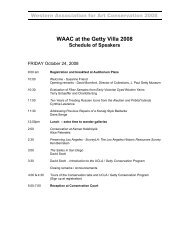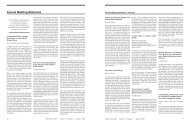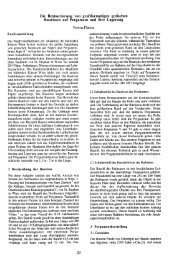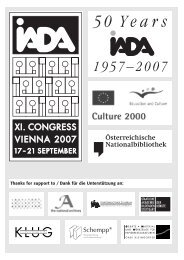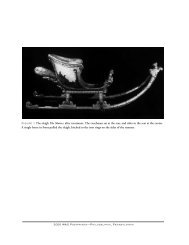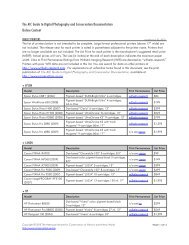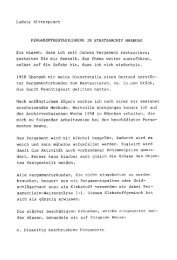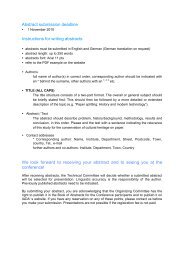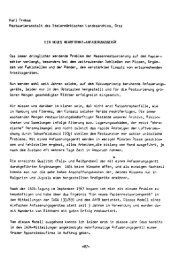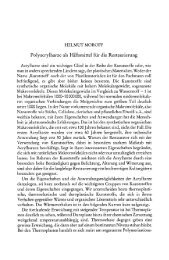Download red list - The International Council of Museums
Download red list - The International Council of Museums
Download red list - The International Council of Museums
You also want an ePaper? Increase the reach of your titles
YUMPU automatically turns print PDFs into web optimized ePapers that Google loves.
Figura Jama Coaque, cerámica, 54 x 28 cm,<br />
Museo Antropológico del Banco Central, Colección<br />
Banco Central del Ecuador<br />
Jama Coaque figure, ceramic, 54 x 28 cm,<br />
Museo Antropológico del Banco Central, Colección<br />
Banco Central del Ecuador<br />
© Banco Central del Ecuador<br />
Urgencia de la situacióne<br />
Estas figuras, que aparecen con gran pr<strong>of</strong>usión desde hace<br />
mucho tiempo, son ahora todavía más buscadas y saqueadas.<br />
Algunas atraen por lo complicado de sus atuendos y ornamentaciones<br />
y otras, en cambio, por la sencillez y la exquisitez<br />
de su factura, así como por la variedad de su iconografía<br />
y formas.<br />
Son piezas habituales en el comercio que llegan a alcanzar<br />
altos precios. Existe un continuo y permanente saqueo<br />
y destrucción de los yacimientos arqueológicos que nos<br />
permitirían ahondar el conocimiento de la sociedad que las<br />
elaboró. Las características del terreno que favorecen la falta<br />
de seguridad, permiten que el huaquerismo o saqueo de<br />
tumbas vaya más rápido que los rescates arqueológicos.<br />
Legislación protectora de estos objetose<br />
Ver Ecuador, p. 63<br />
Vasija Jama Coaque, cerámica, 29,3 x 23,9 cm,<br />
Museo Antropológico del Banco Central, Colección<br />
Banco Central del Ecuador<br />
Jama Coaque figure, ceramic, 29.3 x 23.9 cm,<br />
Museo Antropológico del Banco Central, Colección<br />
Banco Central del Ecuador<br />
© Banco Central del Ecuador<br />
<strong>The</strong>se figurines, found in great numbers, are now even more<br />
valued and subject to looting. Some <strong>of</strong> them are remarkable<br />
due to their fancy clothes and ornaments and others for<br />
their simplicity and the exquisiteness <strong>of</strong> their craftsmanship<br />
and their varied iconography and shape.<br />
<strong>The</strong>se pieces are commonly found in the market, where<br />
they reach extremely high prices. Archaeological sites that<br />
would allow a better understanding <strong>of</strong> the society that manufactu<strong>red</strong><br />
these vessels are constantly looted and destroyed.<br />
<strong>The</strong>ir far-away location makes the implementation <strong>of</strong> security<br />
measures extremely difficult, which explains the high occurrence<br />
<strong>of</strong> tomb looting.<br />
Legislation Protecting these Objectse<br />
See Ecuador, p. 63<br />
Bibliografíae Bibliographye<br />
Figura Tumaco-Tolita, cerámica, 17,8 x 12,6 cm,<br />
Museo Nacional de Colombia, Colección ICANH<br />
Tumaco-Tolita figure, ceramic, 17.8 x 12.6 cm,<br />
Museo Nacional de Colombia, Colección ICANH<br />
© ICANH<br />
<strong>The</strong> Urgency <strong>of</strong> the Situatione<br />
• Alcina Franch, José. El arte precolombino (versión española). Barcelona, 1990.<br />
• Bouchard, Jean Francois & Usselmann, Pierre. Trois millénaires de civilisation entre Colombie et Equateur: La région de Tumaco La Tolita.<br />
Paris, CNRS, 2003.<br />
17<br />
OBJETOS PREHISPÁNICOS PRE-COLUMBIAN OBJECTS



